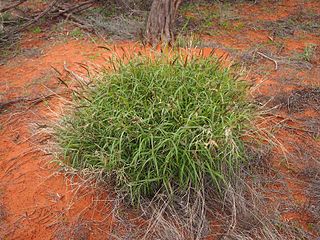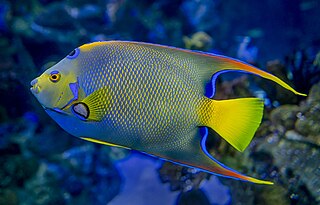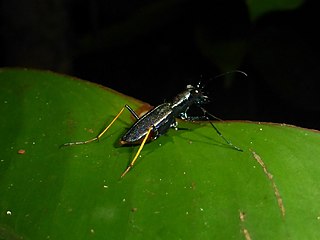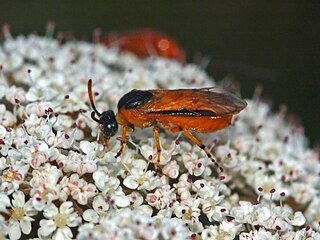
Sir Aaron Klug was a British biophysicist and chemist. He was a winner of the 1982 Nobel Prize in Chemistry for his development of crystallographic electron microscopy and his structural elucidation of biologically important nucleic acid-protein complexes.

Cenchrus ciliaris is a species of grass native to most of Africa, southern Asia, southern Iran, and the extreme south of Europe (Sicily). Other names by which this grass is known include dhaman grass, anjan grass, koluk katai and buffelgrass.

Pentacomia is a genus in the beetle family Cicindelidae. There are more than 50 described species in Pentacomia, found in Central and South America.

The queen angelfish, also known as the blue angelfish, golden angelfish, or yellow angelfish, is a species of marine angelfish found in the western Atlantic Ocean. It is a benthic warm-water species that lives in coral reefs. It is recognized by its blue and yellow coloration and a distinctive spot or "crown" on its forehead. This crown distinguishes it from the closely related and similar-looking Bermuda blue angelfish, with which it overlaps in range and can interbreed.

Hiperantha is a genus of beetles in the family Buprestidae, tribe Stigmoderini, containing the following species:

Omphra is a genus in the beetle family Carabidae. There are about seven described species in Omphra.

Odontocheila is a genus in the beetle family Cicindelidae. There are more than 70 described species in Odontocheila, found in South America, Central America, and Mexico.
Acyphoderes is a genus of beetles in the family Cerambycidae, containing the following species:
Epimelitta is a genus of beetles in the family Cerambycidae, containing the following species:
Odontocera is a genus of beetles in the family Cerambycidae, containing the following species:
Ctenodes is a genus of beetles in the family Cerambycidae, containing the following species:

Arge is a genus of sawflies belonging to the family Argidae subfamily Arginae.

Epicauta is a genus of beetles in the blister beetle family, Meloidae. The genus was first scientifically described in 1834 by Pierre François Marie Auguste Dejean. Epicauta is distributed nearly worldwide, with species native to all continents except Australia and Antarctica. Surveys have found the genus to be particularly diverse in northern Arizona in the United States. Few species occur in the Arctic, with none farther north than the southern Northwest Territory of Canada.

Digitaria ciliaris is a species of grass known by the common names southern crabgrass, tropical finger-grass, tropical crabgrass or summer grass.
Compsosoma is a genus of longhorn beetles of the subfamily Lamiinae.
Icimauna is a genus of longhorn beetles of the subfamily Lamiinae, containing the following species:
Apeba togata is a species of beetle in the family Cerambycidae. It was described by Johann Christoph Friedrich Klug in 1825. It is known from Brazil.
Lycaneptia amicta is a species of beetle in the family Cerambycidae. It was described by Johann Christoph Friedrich Klug in 1825. It is known from Brazil.
Lycidola palliata is a species of beetle in the family Cerambycidae. It was described by Johann Christoph Friedrich Klug in 1825. It is known from Brazil.
Lycomimus ampliatus is a species of beetle in the family Cerambycidae. It was described by Johann Christoph Friedrich Klug in 1825. It is known from Brazil.









